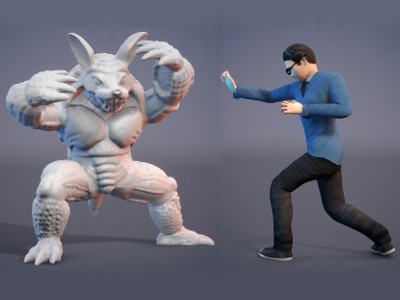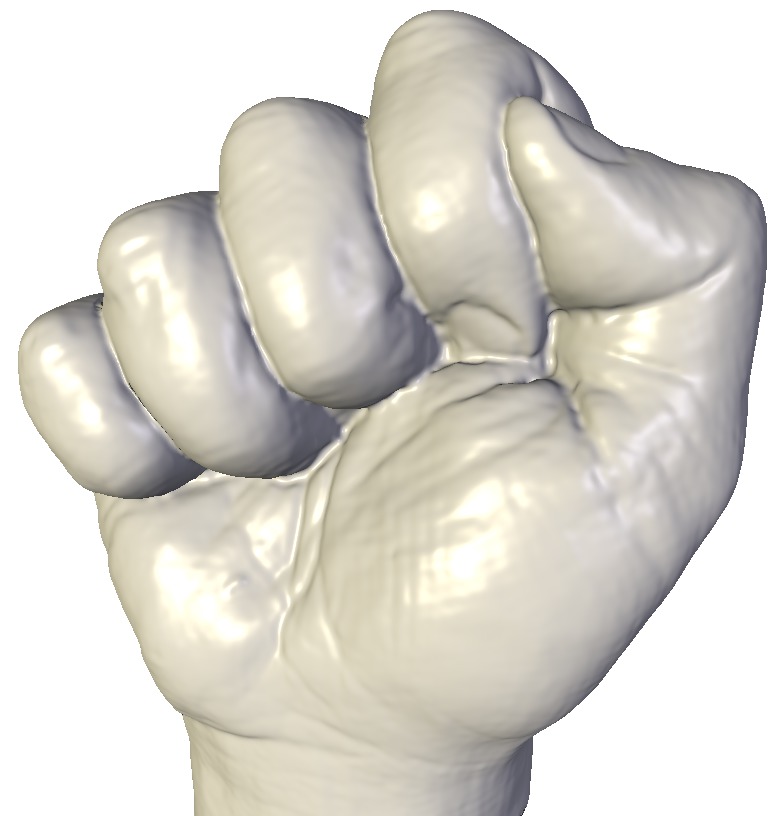Section: New Results
Axis 4: Editing and Modeling
Implicit Skinning and Modeling
Participant: G. Guennebaud
Geometric skinning techniques, such as smooth blending or dual-quaternions, are very popular in the industry for their high performances, but fail to mimic realistic deformations. Other methods make use of physical simulation or control volume to better capture the skin behavior, yet they cannot deliver real-time feedback. In collaboration with IRIT (Toulouse) and the Imagine team (Grenoble), we developed the first purely geometric method handling skin contact effects and muscular bulges in real-time. Our insight is to exploit the advanced composition mechanism of volumetric, implicit representations for correcting the results of geometric skinning techniques (cf. Figure 12 -a). The mesh is first approximated by a set of implicit surfaces. At each animation step, these surfaces are combined in real-time and used to adjust the position of mesh vertices, starting from their smooth skinning position. This deformation step is done without any loss of detail and seamlessly handles contacts between skin parts. As it acts as a post-process, our method fits well into the standard animation pipeline. Moreover, it requires no intensive computation step such as collision detection, and therefore provides real-time performances. This work has been published at Siggraph this year [20] and featured by the 3DVF website http://www.3dvf.com/actualite-6678-siggraph-2013-methode-skinning-implicite.html .
Still in collaboration with IRIT, we addressed the challenging problem
of finding adequate bounds for implicit modeling with compact field
functions. Recent advances in implicit surface modeling now provide
highly controllable blending effects. These effects rely on the field
functions of
In this work we analyzed these shortcomings, and deduced new constraints on field functions such that differences and intersections can be seamlessly applied without introducing discontinuities or field distortions. In particular, we showed how to adapt state of the art gradient-based union and blending operators to our new constraints. Our approach enables a precise control of the shape of both the inner or outer field boundaries. We also developed a new set of asymmetric operators tailored for the modeling of fine details while preserving the integrity of the resulting fields. This work has been published at Shape Modeling International 2013 [14] .
|
Surface reconstruction
Participants: J. Chen, G. Guennebaud, P. Barla, X. Granier
Reconstructing a smooth surface from a set of points is still a challenging problem. Most of the popular techniques assume correctly oriented points as inputs. However, in many situations, computing a consistent orientation of the normal field is as difficult as the reconstruction itself. In a recent work, we extended the Algebraic Point Set Surface method to support non oriented normals (cf. Figure 12 -b). By fitting algebraic spheres, our approach outperforms simple local methods based on non-oriented planar fit while still being fast since it involves only local computations. The core of this new technique also proved to be useful for image processing. This work as been published at Computer Graphics Forum [3] .
Manipulation of Anisotropic Highlights
Participants: B. Raymond, P. Barla, G. Guennebaud, X. Granier
We have developed [19] a system for the direct editing of highlights produced by anisotropic BRDFs, which we call anisotropic highlights. We first provide a comprehensive analysis of the link between the direction of anisotropy and the shape of highlight curves for arbitrary object surfaces. The gained insights provide the required ingredients to infer BRDF orientations from a prescribed highlight tangent field. This amounts to a non-linear optimization problem, which is solved at interactive framerates during manipulation. Taking inspiration from sculpting software, we provide tools that give the impression of manipulating highlight curves while actually modifying their tangents. Our solver produces desired highlight shapes for a host of lighting environments and anisotropic BRDFs.




